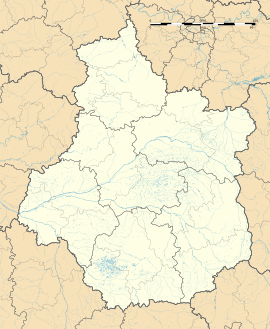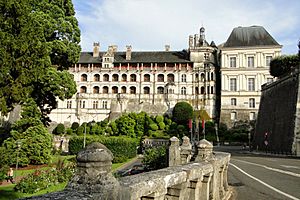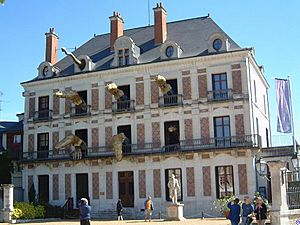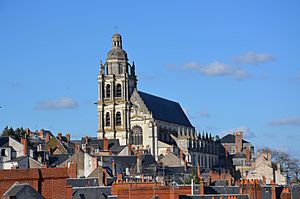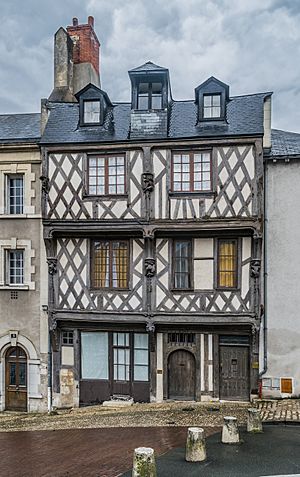Blois facts for kids
Quick facts for kids
Ville de Blois
|
||
|---|---|---|
|
Prefecture and commune
|
||

Panoramic view of Blois on the Loire river, from Vienne, on the left bank
|
||
|
||
| Country | France | |
| Region | Centre-Val de Loire | |
| Department | Loir-et-Cher | |
| Arrondissement | Blois | |
| Canton | Blois-1, 2 and 3 and Vineuil | |
| Intercommunality | CA Blois Agglopolys | |
| Area
1
|
37.46 km2 (14.46 sq mi) | |
| Population
(2021)
|
46,813 | |
| • Density | 1,249.68/km2 (3,236.7/sq mi) | |
| Demonym(s) | Bloisian French: Blésois(e) |
|
| Time zone | UTC+01:00 (CET) | |
| • Summer (DST) | UTC+02:00 (CEST) | |
| INSEE/Postal code |
41018 /41000
|
|
| Elevation | 63–135 m (207–443 ft) (avg. 73 m or 240 ft) |
|
| 1 French Land Register data, which excludes lakes, ponds, glaciers > 1 km2 (0.386 sq mi or 247 acres) and river estuaries. | ||
Blois ( blwah;) is an important city in France, located on the banks of the Loire river. It is the capital city of the Loir-et-Cher department in the Centre-Val de Loire region. Blois is found between the cities of Orléans and Tours.
With about 46,000 people living there in 2019, Blois is the biggest city in its department and the fourth largest in its region.
For a long time, Blois was the capital of the County of Blois. This county was created in 832 and became part of the French royal lands in 1498. This happened when Count Louis II of Orléans became King Louis XII of France. During the Renaissance period, Blois was a special home for the King of France.
Contents
History of Blois
Early Times
Since 2013, archaeologists have been digging in an area of Blois called Blois-Vienne. They found signs of ancient hunter-gatherers who lived there thousands of years ago. These early people were also fishermen, and they used traps to catch fish. These findings show that people lived in this area around 8,000 years ago, even before the famous Neolithic farmers.
Later, around 1959, more discoveries were made. These showed that Blois was a developed town during the Gallo-Roman period. At that time, it was on a main road connecting two other important towns. The Loire river was always a key route for travel and trade. Even though no old ports have been found, there are signs of old bridges that once connected the two sides of the river.
Middle Ages
Blois was first clearly mentioned in the 6th century. It became well-known in the 9th century as the home of a powerful group of rulers called the Counts of Blois.
The first counts of Blois were from the Robertian family. Around 940, Theobald I became count. His family, known as the "Thibaldians," ruled Blois until 1397, when the county became part of the French royal lands. Members of this family also became kings and queens in other European countries like France, England, and Spain.
In 1171, the Jewish community in Blois faced a difficult time, leading to the deaths of many people. This event inspired a lot of poetry. In 1196, Count Louis I of Blois gave special rights to the townspeople. This likely led to the creation of a local government that lasted throughout the Middle Ages. The oldest parts of the Château of Blois (from the 13th century) were built by these counts.
In 1429, Joan of Arc used Blois as her base when she went to help the city of Orléans. She rode 35 miles from Blois to Orléans to help lift the siege. In 1440, Duke Charles of Orléans came to live in the Château of Blois after being held captive in England. His son, Louis II of Orléans, who would later become King Louis XII, was born there in 1462.
Renaissance Era
In 1498, King Charles VIII died without children. Because of this, Duke Louis II of Orléans became King Louis XII of France. He then married Charles VIII's widow, Queen Anne of Brittany. Their daughter, Claude of France, helped unite Brittany with France. King Louis XII, being the last Count of Blois, made the city his royal home.
During his rule, Blois grew a lot. Many buildings were inspired by the Italian Renaissance style. The old medieval castle was turned into a beautiful château, and many fancy private mansions (called hôtels particuliers) were built for important noble families. One famous mansion, Hôtel d'Alluye, was built like an Italian palace for Florimond Robertet, an important minister.
King Louis XII died on January 1, 1515. His son-in-law, Francis I, became the next king. In 1519, King Francis I started building the huge Château of Chambord near Blois. However, he slowly began to prefer Fontainebleau near Paris and started to leave Blois. By 1539, much of the royal furniture was moved away.
The French Wars of Religion were a very difficult time in France. Blois had many Protestants, and the city saw fights between them and Catholics in 1562 and 1567. In 1576 and 1588, King Henry III held important meetings called the Estates General in Blois. During this time, two powerful brothers, Duke Henry I of Guise and Cardinal Louis II of Guise, were assassinated in Blois. The Queen-Mother, Catherine de' Medici, also died shortly after.
Early Modern Era
After the royal court moved to Paris, Blois became less important. King Henry IV moved the royal library from Blois to Fontainebleau.
In 1606, the village of Vienne-lez-Blois on the left bank of the Loire river became part of Blois, and is now known as Blois-Vienne. From 1617 to 1619, Marie de' Medici, the wife of King Henri IV, lived in the Château of Blois after being sent away from the court by her son, King Louis XIII. In 1634, King Louis XIII sent his brother, Gaston, Duke of Orléans, to live in Blois. Gaston became very fond of the city and helped build a hospital and rebuild another important building. He stayed in Blois until he died in 1660.
Under King Louis XIV's rule, Blois became its own bishopric (a church district led by a bishop). The St. Solenne Church, which had been damaged by a storm, was rebuilt and became the main cathedral in 1700. A large palace for the bishop was also built next to the cathedral, overlooking the Loire Valley. These gardens were opened to the public in 1791 after the French Revolution.
In 1716, the old medieval bridge across the Loire collapsed. A new one, the Jacques-Gabriel Bridge, was built and opened in 1724.
After Duke Gaston of Orléans died, the Château of Blois was left empty by King Louis XIV. It was so neglected that King Louis XVI even thought about tearing it down in 1788. Luckily, it was saved when a military regiment moved in. In 1790, Blois became the capital of the new Loir-et-Cher department.
Modern Times
In the 19th century, Blois saw many changes. The railroad arrived in 1846, connecting Blois to Paris and Tours. This made river transport less important. The city also became more industrial, especially with the success of a chocolate brand created by Victor-Auguste Poulain in 1848.
Between 1850 and 1870, Mayor Eugène Riffault redesigned parts of Blois, similar to how Paris was changed. He built new roads and boulevards, connecting the higher, modern parts of the city with the older, medieval lower town. The famous Denis-Papin staircase was also built during this time, offering great views of the city.
The lower parts of Blois faced severe floods from the Loire river in 1846, 1856 (the worst), and 1866.
During the Franco-Prussian War in 1871, the Prussian army took control of Blois for a short time before it was taken back by French forces. A memorial now stands to remember this event.
In 1939, the Blois Basilica was finished. In June 1940, during World War II, German bombings destroyed much of downtown Blois. The French army also destroyed part of the Jacques-Gabriel Bridge to slow down the German advance. The German army took over the city on June 18, 1940.
Between June and August 1944, Allied bombings caused more damage, especially to railway bridges. In total, 230 people were killed in Blois during WWII, and many buildings were destroyed. On August 16, 1944, German troops retreated and destroyed three central arches of the Jacques-Gabriel Bridge. They surrendered on September 1st. The bridge was rebuilt and reopened in 1948.
In 1959, a new mayor started building a large new area in the north of the city, similar to modern suburbs in other French cities.
Population
| Historical population | |||||||||||||||||||||||||||||||||||||||||||||||||||||||||||||||||||||||||||||||||||||||||||||||||||||||||||||||||||
|---|---|---|---|---|---|---|---|---|---|---|---|---|---|---|---|---|---|---|---|---|---|---|---|---|---|---|---|---|---|---|---|---|---|---|---|---|---|---|---|---|---|---|---|---|---|---|---|---|---|---|---|---|---|---|---|---|---|---|---|---|---|---|---|---|---|---|---|---|---|---|---|---|---|---|---|---|---|---|---|---|---|---|---|---|---|---|---|---|---|---|---|---|---|---|---|---|---|---|---|---|---|---|---|---|---|---|---|---|---|---|---|---|---|---|---|
|
|
||||||||||||||||||||||||||||||||||||||||||||||||||||||||||||||||||||||||||||||||||||||||||||||||||||||||||||||||||
| Source: EHESS and INSEE (1968–2017) | |||||||||||||||||||||||||||||||||||||||||||||||||||||||||||||||||||||||||||||||||||||||||||||||||||||||||||||||||||
Landmarks and Tourism
Since 1986, Blois has been part of the "French Towns of Art and History" program. This program helps promote the city's rich culture and history.
-
Lodges Façade of the Château of Blois, on Francis I wing, seen from Victor-Hugo Square.
-
Rosarium in the Bishopric Gardens.
Château of Blois
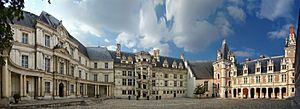
The Château of Blois is a famous castle in the city center. It has many different architectural styles from the Renaissance period. This castle was once home to King Louis XII and many powerful Counts of Blois. Around the château, you can find several beautiful gardens, including:
- the St. Sauveur Garden (Parterre Saint-Sauveur);
- the Lily Garden (Jardin des Lices);
- the King's Stronghold (Bastion du Roi);
- and Victor Hugo Square (Square Victor Hugo).
House of Magic
Right across from the château is La Maison de la Magie Robert-Houdin, also known as the Robert-Houdin House of Magic. This museum is all about illusionism and magic tricks. It's the only public museum in Europe that combines magic collections with live performances. It celebrates the famous magician Jean-Eugène Robert-Houdin.
Louis-XII Place and Fountains
This square was opened after bombings in 1944. It's located right below the château, close to the Loire river, and is a central spot in downtown Blois. You'll find shops and restaurants here. A 16th-century fountain, called Louis XII Fountain, stands among the trees. It's one of the oldest and largest water sources in the city.
Other fountains in Blois include:
- St. Martin Fountain (Fontaine Saint-Martin);
- St. Nicholas Fountain (Fontaine Saint-Nicolas);
- Elected Representatives' Fountain (Fontaine des Élus);
- Ave Maria Fountain (Fontaine Ave Maria);
- Town hall Fountain (Fontaine de l'Hôtel de Ville);
- St. Jack Fountain (Fontaine Saint-Jacques);
- Corbigny Fountain (Fontaine de Corbigny);
- and Simple Fountain (Fontaine des Simples).
Comics Museum
Blois is also home to the Maison de la BD, a museum dedicated to the art of comic books. Since the 1980s, this museum hosts an annual comic festival in late November called BD Boum, which is known as a leading free comic book festival in France.
Former Hôtel-Dieu
In the 13th century, a church was built on the bank of the Loire river, outside the city walls. It was later fortified during the Hundred Years' War. The original church, called St. Lomer Abbey, was destroyed during the French Wars of Religion but rebuilt by the early 18th century. During the French Revolution in 1789, the church was turned into an Hôtel-Dieu, which was a charity hospital for those in need. Today, this area is being studied for new uses.
Former Poulain Chocolate Factory
In the late 19th century, the famous chocolatier Victor-Auguste Poulain built his chocolate factory next to the Blois train station. The factory moved in the 1980s. Now, the old factory buildings are used for housing and for the National Institute and School of Applied Sciences (INSA).
Denis-Papin Staircase
Blois is built on steep hills, so there are many winding paths and staircases. The most famous one is the huge Denis-Papin staircase. It offers amazing views of the downtown area and the Loire Valley. This staircase is often decorated with fun and original art. A fountain next to the staircase reminds us where the first Town Hall used to be before it was destroyed in 1940.
Town Hall and Bishopric Gardens
Blois became its own church district in 1697, and the cathedral was finished by 1700. The first bishops then created large gardens on different levels next to the cathedral. After the old Blois town hall was destroyed during World War II, the city government moved into the bishop's apartments. Now, these gardens are a public park with great views of downtown, the Loire river, and Blois-Vienne. A statue of Joan of Arc stands in the park. The Bishopric Gardens are open all year, and a beautiful rose garden can be visited from May 15 to September 30.
Historic Mansions and Timber-Framing Houses
When Louis II of Orléans became King Louis XII of France in 1498, many noble families came to live in Blois. They built their own grand mansions, called hôtels particuliers, as close to the château as possible. King Louis XII also brought the Renaissance style from Italy. Some of these famous mansions include:
- the Hôtel d'Alluye;
- the Hôtel d'Amboise;
- the Hôtel de Belot;
- the Hôtel de la Capitainerie;
- the Hôtel de la Chancellerie;
- the Hôtel Denis-Dupont;
- the Hôtel d'Épernon;
- the Hôtel de Guise;
- the Hôtel de Jassaud;
- the Hôtel de Lavallière;
- the Hôtel de Rochefort;
- the Hôtel Sardini;
- the Hôtel Viart;
- the Hôtel de Villebresme, where Denis Papin lived;
- and the Château de la Vicomté.
Many ordinary citizens also built unique timber-framing houses throughout the city, such as:
- the Logis du Loup;
- and the Maison des Acrobates.
All these buildings are now protected as historical monuments.
Blois-Vienne and the Loire River

Blois-Vienne is the southern part of Blois, located on the left bank of the Loire river. It was a separate town until 1606. The main connection between the two banks is the Jacques-Gabriel Bridge, built in the early 18th century. Vienne also has an old harbor called La Creusille, which is now a park and part of the La Loire à Vélo bike route. Beyond the riverbanks, La Bouillie Park is a special area designed to handle floods. Further south, the Forêt de Russy forest reminds us of the thick woods that once covered the region.
Religious Buildings
Blois has many beautiful religious buildings, including:
- Blois Cathedral, dedicated to Kings Louis IX and Louis XII, built between 1564 and 1700.
- St. Vincent Blois Church, built between 1625 and 1660.
- St. Nicholas Blois Church, built in the 12th century.
- Blois-Vienne Church, built between 1500 and 1528.
- The Basilica of Notre-Dame de la Trinité, built between 1932 and 1939.
Transport
The A10 motorway connects Blois to Paris, Orléans, and Tours. The Blois Railway Station offers direct train connections to Paris, Orléans, Tours, and Nantes, as well as other regional places.
You can also find regular bus connections from Blois to nearby cities and attractions, such as:
- Chaumont-sur-Loire (by train),
- Château of Chambord (by bus),
- Montrichard (by bus),
- Vendôme (by bus),
- and ZooParc de Beauval (by bus).
Famous People from Blois
Many interesting people have lived in or been connected to Blois throughout history. Here are a few:
Historical Figures
- King Louis XII (1462–1515): He was the Count of Blois before becoming King of France. He made Blois his royal home.
- Anne of Brittany (1477–1514): Queen of Brittany, she married King Louis XII and lived in Blois.
- King Francis I (1494–1547): Son-in-law of Louis XII, he also lived in Blois and started building the famous Château of Chambord nearby.
- Catherine de' Medici (1519–1589): A powerful Queen of France who died in the Château of Blois.
- Marie de' Medici (1575–1642): Another Queen of France, she was sent to live in the Château of Blois by her son.
- Gaston, Duke of Orléans (1494–1547): Uncle of King Louis XVI, he lived in the Château of Blois and helped improve the city.
- Denis Papin (1647–1713): A famous physicist, mathematician, and inventor from Blois. The large staircase in the city is named after him.
Artists and Writers
- Pierre de Ronsard (1524–1585): A famous French poet who met his muse in the Château of Blois.
- Jean-Eugène Robert-Houdin (1805–1871): A watchmaker and magician, often called the "father of modern conjuring." The House of Magic in Blois is named after him.
- Claudine Doury (born 1959): A well-known photographer.
- Niro (born 1987): A popular rapper who grew up and lives in Blois.
Craftsmen
In the 16th and 17th centuries, Blois was known for its skilled watchmakers and goldsmiths. Many of their beautiful works can be found in museums around the world today. Some famous families and individuals included:
- Julien Coudray, who worked for Kings Louis XII and Francis I.
- The Cuper family and Bellanger family, known for their watches.
- Jacques de la Garde, whose clocks are in famous museums.
- Nicolas Lemaindre, who was a watchmaker for Queen Catherine de' Medici.
International Relations
Blois is connected with several cities around the world. These connections are called "twin towns" or "sister cities," and they help promote friendship and understanding between different cultures.
Blois is twinned with:
 Waldshut-Tiengen, Germany (since 1963)
Waldshut-Tiengen, Germany (since 1963) Weimar, Germany (since 1995)
Weimar, Germany (since 1995) Lewes, United Kingdom (since 1963)
Lewes, United Kingdom (since 1963) Sighişoara, Romania (since 1995)
Sighişoara, Romania (since 1995) Urbino, Italy (since 2003, a "friendship protocol")
Urbino, Italy (since 2003, a "friendship protocol") Huế, Vietnam (since 2007)
Huế, Vietnam (since 2007) Azrou, Morocco (since 2011, a cooperation agreement)
Azrou, Morocco (since 2011, a cooperation agreement)
See also
 In Spanish: Blois para niños
In Spanish: Blois para niños




